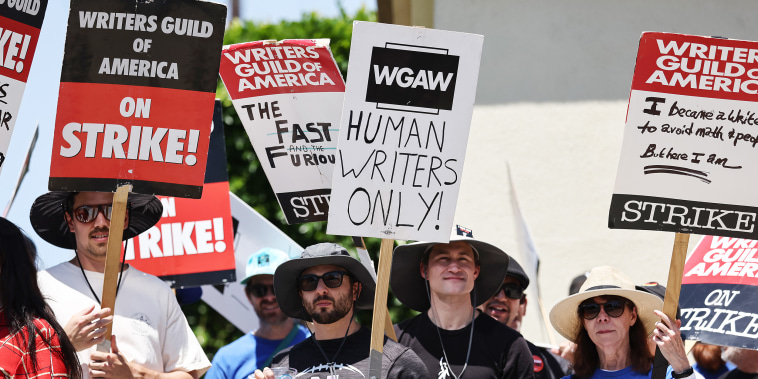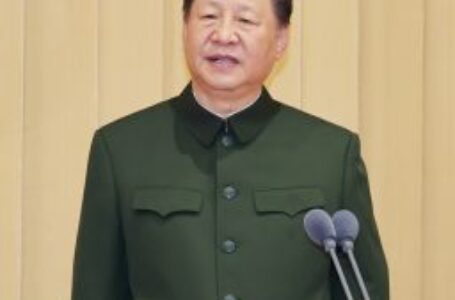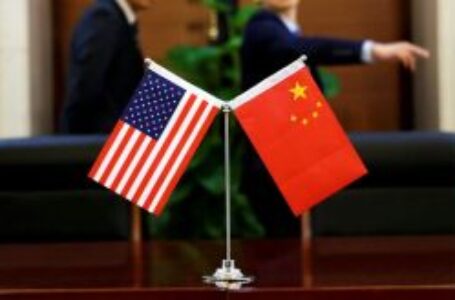Daughter of prominent Palestinian poet killed in Israeli airstrike in Gaza
Workers wrested a seat at the table on AI this year. Will it be enough?


2023 saw workers demand more say over how artificial intelligence reshapes their industries, scoring unprecedented wins from Hollywood to Silicon Valley. But as the technology barrels forward and regulators race to keep up, labor experts say it’s an open question how effective the push will prove.
Earlier this month, Microsoft and the AFL-CIO, a coalition of dozens of unions representing 12.5 million people, announced a partnership “to expand workers’ role in the creation of worker-centered design, workforce training and trustworthy AI practices,” as AFL-CIO President Liz Shuler described it in a news release.
The deal is short on details but includes “learning sessions” with labor leaders and workers facilitated by Microsoft’s AI experts. It also outlines plans for the two organizations to propose new policies to Congress around AI upskilling that would help create and preserve jobs for humans as the technology expands.
“Education and dialogue are the best starting places,” said Seth Harris, a law and policy professor at Northeastern University who was President Joe Biden’s top labor adviser until last year. “Workers must have power in any relationship that involves them sitting down to discuss difficult topics.”
Harris and other experts praised the move but said its most significant feature was Microsoft’s commitment to remaining neutral in labor organizing, rather than any AI-specific policies. That framework is similar to the one Microsoft agreed to with workers at Activision Blizzard, the videogame maker it acquired in a deal that closed in October.
“For one of the largest and highest-profile companies in the world to recognize that joining a union should be workers’ choice, and their choice alone, is an important signal to the large majority of employers who aggressively attack any effort at worker organizing,” Harris added.
The AFL-CIO declined to comment. Microsoft pointed to its public statements and labor policies but didn’t comment further.
The agreement comes on the heels of a recent leadership drama at OpenAI, the maker of ChatGPT, that resolved with major investor Microsoft pushing to reverse the startup’s firing of CEO Sam Altman and eventually securing a nonvoting role on the company’s board.
Industry experts largely viewed Microsoft as emerging from the saga in a strong position to continue steering AI development in line with its business goals — a situation that labor experts said could limit the impact of workers’ new inroads.
While the AFL-CIO alliance is “a very positive development,” said Kate Bronfenbrenner, director of labor education research at Cornell University, big questions remain.
“Are workers actually going to have a say over AI?” she asked. “What if the workers get involved and they say, ‘You know what, it’s too much of a problem’? Of course the company’s not going to stop doing it,” Bronfenbrenner speculated, adding that Microsoft might be seeking “positive press” following scrutiny of its Activision takeover.
Workers are pushing to protect their jobs from AI-fueled automation beyond the tech sector, too. In recent months, screenwriters and actors ratified new contracts limiting film and TV studios’ ability to deploy AI to generate scripts or virtual performers — and specifying how to compensate writers and actors when they do.
A London rally in solidarity with striking U.S. workers in July.Betty Laura Zapata / Bloomberg via Getty Images file
Those concessions were partly a case of lucky timing, with three major Hollywood unions’ contracts all up for renegotiation just as interest in generative AI exploded across industries. While labor leaders touted their wins as groundbreaking and the contracts were approved by wide margins, the AI provisions didn’t escape criticism.
Some actors had wanted stronger curbs on the use of their likenesses to train AI models. Alex Plank, a SAG-AFTRA member, told NBC News earlier this month that he was disappointed that studios looking to use virtual actors “just have to notify SAG and bargain with the union” over doing so, which he called tantamount to “allowing synthetic performers to compete with human ones.”
In a forthcoming Nielsen survey of 3,000 U.S. workers conducted this fall and viewed by NBC News, many reported feeling conflicted about AI’s future impact on their livelihoods. While about 36% of those surveyed said tools like ChatGPT would make their jobs easier, more than half were concerned AI would reduce their professional opportunities.
Charlene Polite Corley, vice president of diverse insights and partnerships at Nielsen, said the initiative between Microsoft and the AFL-CIO could ease some of those worries.
“One key benefit of this partnership could be inclusion of more socioeconomic diversity throughout the development of AI solutions and policies,” she said. “With the rate of adoption of this technology just in the last year, there hasn’t always been that pause to evaluate how AI may increase inequity.”
The White House has sought to boost labor in a year of historic worker organizing, with Biden joining a United Auto Workers picket and championing new rulings by the National Labor Relations Board making it easier for more employees to unionize.
“The Biden-Harris administration firmly believes that workers need a seat at the table in the development and use of AI,” said Muneer Ahmad, senior counsel to the secretary at the Department of Labor. He hailed the pact at Microsoft as a potential “model for other labor-management partnerships.”
In the meantime, Bronfenbrenner said labor advocates have their work cut out in navigating the proliferation of AI tools in the workplace, particularly those for tracking and improving productivity. Some “tattleware” that expanded rapidly during pandemic-era remote work can take screenshots of company-issued devices without alerting employees, as well as log their keystrokes or website visits.
“And that’s just the surveillance that we’re aware of,” she said. “We need to learn a lot about how it’s affecting workers in industries from media to technology to education. Are there ways it can be helpful, or is the primary purpose of it going to be to just cut costs and replace workers?”











